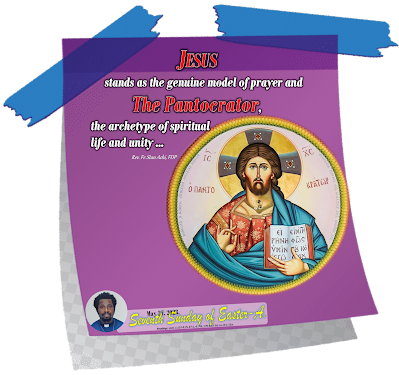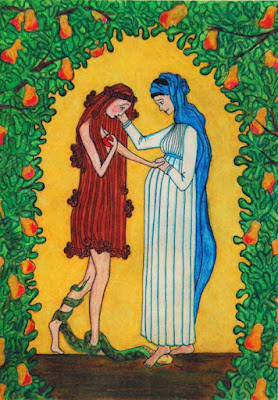CHRIST THE PANTOCRATOR, ARCHETYPE OF PRAYER AND UNITY.
May 21, 2023.
Seventh Sunday of Easter – A.
Readings: Acts 1:12-14; Ps 27:1, 4, 7-8; 1 Pt 4:13-16; Jn17:1-11a.
“I pray for them...” Jn 17:9
An Irish proverb says: “There is no strength without unity.”
And an Arabic proverb adds about prayer: “Prayer is the pillow of religion.”
Jesus Christ as Pantocrator, meaning “Almighty,
All-Powerful,” is the Greek word used by Paul to describe the Lord in 2
Corinthians 6:18 and many times by John in the Book of Revelation: 1:8; 4:8,
and many others. Here, we are given to see and contemplate our Lord Jesus
Christ as above all things and all-powerful. He is the fulfillment of everything,
and all comes to being and is made possible through him.
While we are nearing the close of our Easter journey, the
image of the Pantocrator is what fits the most to the Risen Lord. Nothing is
beyond his reach. In his passion, death, and resurrection, he has brought all
things and promises to their completion. Thus, his words, while dying on the
Cross, "Consummatum Est." For, he accomplished everything in his
blood shed on the Cross. He accomplished all the mysteries and revealed all
about God.
The Catechism says: "Jesus fulfilled the work of the
Father completely; his prayer, like his sacrifice, extends until the end of
time. The prayer of this hour fills the end-times and carries them toward their
consummation. Jesus, the Son to whom the Father has given all things, has given
himself wholly back to the Father, yet expresses himself with a sovereign
freedom by virtue of the power the Father has given him over all flesh. The
Son, who made himself Servant, is Lord, the Pantocrator. Our high priest who prays
for us is also the one who prays in us and the God who hears our prayer."
CCC 2749
In order to have all things fulfilled, Jesus was in an
intimate and unequaled relationship with his Father. Hours before his Passion,
he expressed that relationship through the great Sacerdotal prayer. Through
this prayer, he shows that he is truly our Pantocrator and unique High Priest
and mediator of all graces. He prayed for his own glorification. He prayed for
his disciples. He prayed for those who will come unto faith through their
preaching. He prayed for you and me. The Lord knew that his hour has come. He
also knew that life was going to be tough for his followers, once he will no
longer be amidst them. But that this was the only way for them to prove their
faith in him and so be saved. The prayer of the Lord is an inspiration for you
and me, in hours of trials and great decisions, our unique rescue and recourse
should be prayer.
The readings of this seventh Sunday of Easter remind us that
even though Jesus is no longer with his disciples in his human body, he is
still connected to them, and each one of us in prayer. In the first reading,
the community of believers understood it quite well. The historian Luke says
that "All these devoted themselves with one accord to prayer." After
the Ascension, nothing could bring the disciples together and keep them firm
but prayer. It became the reason, the source, and the strength of the first
Christian community. Community prayer is an armor, a shield, and a powerful
weapon against all adversities. It is the means of communion, communication,
and unity with the Lord. And the real strength of any community springs from
the unity of its members. A community where there is no unity and communion of
prayer bears in itself the seed of its dislocation. The disciples of Jesus
devoted themselves to prayer for a solid and harmonious community.
Through this prayer, the disciples were able to develop
patient endurance and courage in trials, facing all things with joy, and giving
praise to God in all things. They were not ashamed to go through suffering for
the Lord's name's sake. As Christians, we should reach also this point. For
Christ is our Pantocrator, always by our side.
The Gospel itself is a long prayer, what the exegetes agreed
to call the “Sacerdotal Prayer” of Jesus. It is a spiritual testament filled
with insights. John 17 can be seen as the expression of a genuine prayer for it
reveals the inmost being of Jesus. One could say, it is a unique opportunity to
see the nature and heart of Jesus. In prayer, he said all about his love for
his disciples, his concern for them, and his will after he will be taken away
from them. This chapter provides valuable insight into the purposes of Jesus's
suffering. He prayed that those who believed in Him would be protected, have
joy, be sanctified, be filled with the Father's love, and truly know His Father
and have eternal life. In that, Jesus stands as the genuine model of prayer and
the Pantocrator, the archetype of spiritual life and unity. He is a model we
should all incarnate and follow.
And finally, the second reading is a call for endurance in faith and good work. The Apostle Peter, in his pastoral exhortation, tells the believers that genuine faith springs from patient endurance of trials and resolution to not be an evildoer, intriguer, thief, or murderer. In everything, we should aim at good action and firmness in the Lord.





Comments
Post a Comment